|
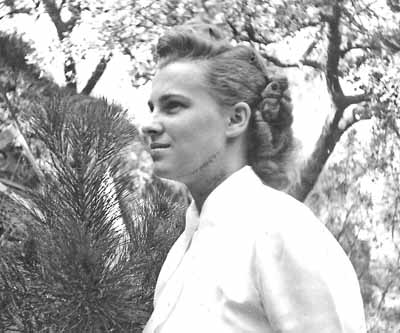
Ruth, before (or after?) plastic surgery to remove scars
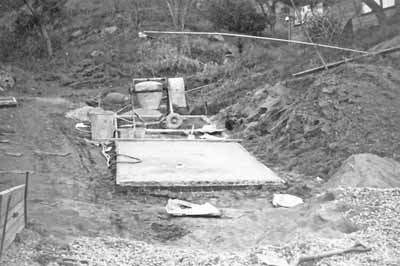
The start of paving a driveway. Note: the ingenious method of lighting the work area at night! (long pole holding light does not get in the way of work)
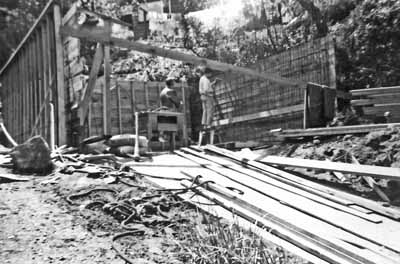
Forming the garage
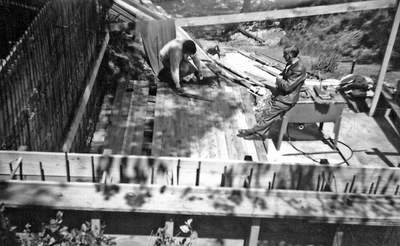
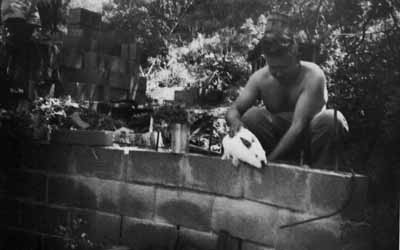
The couple raised rabbits starting around this time and started terracing
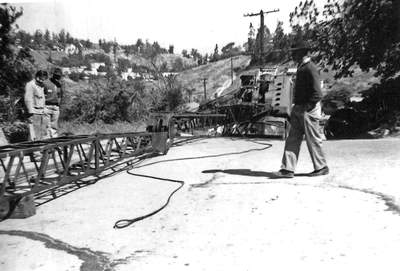
Getting crane set up

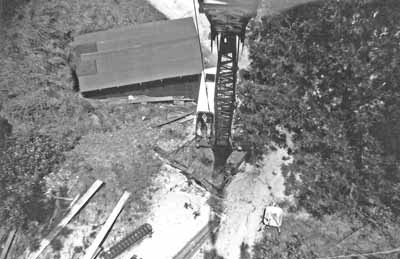
RUTH! Looking down from hopper toward base of crane
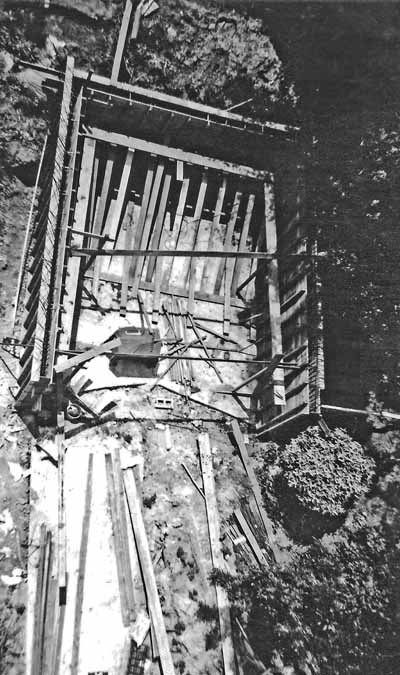
Ruth also took this photo from bucket on crane taken on the same day as the crane boom failed. Bob recalls: "while we awaited arrival of the 3 cement trucks who telephoned that they were lost out on the section of Landa St that was the other side of Silverlake, the ultimate cause of the cement hardening in the bucket which in turn sent the un-emptied bucket racing back to be refilled, too heavy and the boom collapse across Fellowship Drive, so 2 truckloads had to be watered down and disposed of after we could unblock Fellowship). WE HAD THE CRANE PARKED THERE FOR 2 WEEKS!"

Support for roof form
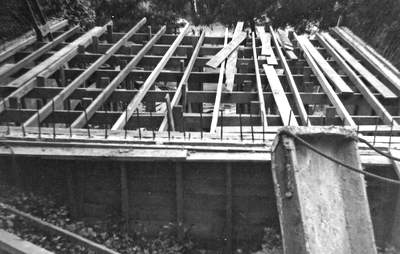
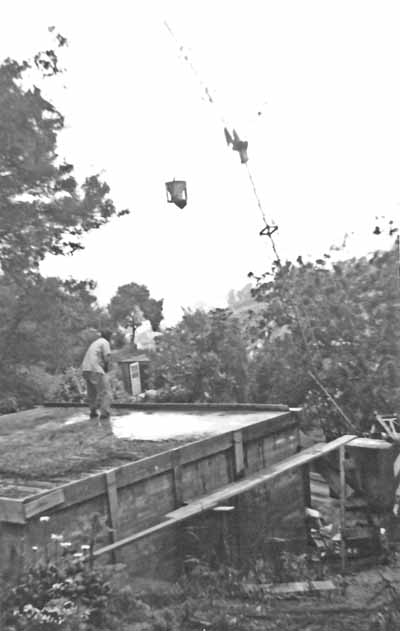
THE CONCRETE IS TRANSPORTED TO THE SITE!

Starting a railing around garage roof
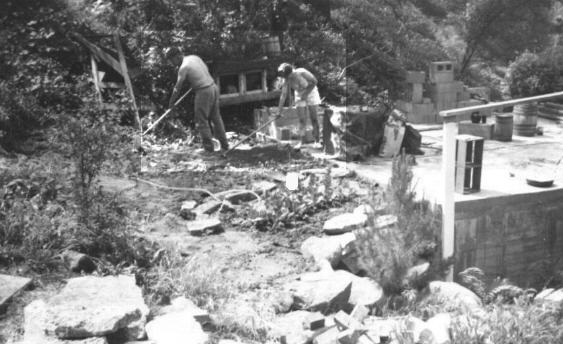
Bob and Ruth working in garage roof area

Start of fence around garage roof
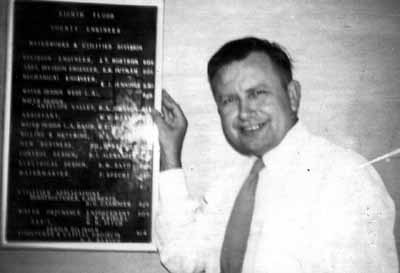
Bob was transfered to the Mechanical Dept. of the Waterworks this year, moving to 8th floor of l08 W 2nd
|
Ruth got plastic surgery performed to fix the scar on her neck.
The concrete garage was completed this year. Ruth had some interesting and helpful neighbors on Landa Street. One was Charlie Hanna. He was an older man who was born circa 1880, and was very knowledgeable on how to do pretty much anything.
He noticed Ruth struggling to carry buckets of sand up the hill one day, and carved her a yoke, so that she could use her shoulders to carry 2 buckets with less stress on her body.
Over the years he gave sage advice to Ruth -- who soaked up such knowledge like a sponge. She was always fond of Charlie.
Robert recalls on Bob and Ruth's collaboration from 1947 to 1961:
"We kept at a stiff program of earning money and using all of our spare time for our do-it-yourself home for 14 years with annual breaks for a 2-week vacation -- clean living with minimum pleasures. About this year, we began talking about children and enlarged the house to about 1500 sq. ft. We were required by the city to build a garage. The house furnishings were the cheapest. We had a minimum social life, entertaining few friends, and mostly relatives."
Robert remembers his first county job:
I passed this written test and was interviewed for the position of Senior Civil Engineering Assistant in 1950 by Randle Lunt, who was in charge of the Waterworks Division of the Mechanical Department of the County of Los Angeles. One of Lunt’s responsibilities was the management of waterworks that served 12 scattered populations in the county totaling about 10 thousand households. The Division employed about 30 people who operated the water well pumps, plugged the water main leaks, read the water meters, prepared and mailed water bills, collected money and shut off the water supply to households quickly after it was noticed that payment was overdue.
The staff that Lunt supervised consisted of one contract resident who usually resided near each of the 12 waterworks, who also was one of the local plumbers, Two meter readers shared reading the 10 thousand meters each month. (They also visited each house and rang the doorbell once each month, as a convenience for customers to pay.),
Two clerks who prepared the water bills, recorded payments on a ledger with pen and ink including any charge for turning the shut-offs back on.
The County Board of Supervisors, during the previous years had been forced into the water business, which usually was a private business enterprise failure. Failure of such enterprises would leave enterprise customers destitute. While I continued a career helping to manage such water districts, the County continued in its population growth to have various other water service problems and with each of these, the Board would refer such problems to the Board’s legal staff, who would pass on the technical details to Lunt.
Populations growing faster than the development of water resources demand the attention of the local government. Land owners usually seek other people’s money to construct the infrastructure needed to support their land developments. If limited local water supplies can somehow be extended, community growth becomes feasible. If such things are demanded at Board meetings, the Board expects its legal staff and Lunt to report back to them the procedure, the details and the costs to satisfy these demands. If the problem was about water supply, Lunt and his staff became accustomed to jump through the hoops.
Examples of such problems are as follows: 1. A small Mutual Water Company, isolated has a single water well drilled down to bedrock. The underground overpumped water table level has descended below the level of the bedrock. The same water table level has 200 feet of underground available water if a 300 foot deep well is drilled. The cost of laying a pipe and drilling and equipping the suggested well is $50,000 which could be raised following a petition, election, formation of a tax district and sale of municipal bonds. Petitioners have a choice to either be County Board or self governed.
2. A large coastal community, bordering on the Pacific Ocean has a number of private water supply enterprises and has so overpumped the underlying water basin that sea water has intruded the basin, contaminating the enterprise’s water well supply. Imported water may be available if a contracting agency is formed and if a $10 million municipal debt is authorized by the voters. Lunt is asked to prepare a report including a preliminary design, cost estimate and a sample petition. Included with the petition is a negotiated promise that an existing agency has agreed to sell the water needed to hold back the sea water intrusion.
3. Another example was when the State Water Project, designing a canal , pumping, plants and reservoir to transport Northern California water to the south, found that communities in the south had no southern contracting agencies in existence to deliver the product and inspired communities to organize to make such contracts. The Board asked Lunt and his crew to study the problem . Lunt ‘s crew began an assembly line to draft the plans, estimates, and petitions needed to create a dozen such contracting agencies that extended beyond Los Angeles County into the surrounding Counties of Ventura. Kern, San Bernardino, Riverside and Orange.
The forgoing describes part of my work in the water business from which I retired in March 1978. Other parts mainly either consisted of consultations of individual citizens with water problems who had been referred to us or consisted of designing water improvements for County Parks, Jails, Hospitals, Camps and remote isolated facilities.
One odd-ball assignment was to design the County Air Raid Warning System. Our crew pioneered with the introduction of computers, remote control systems, radio communication. Other County Departments soon followed our example.
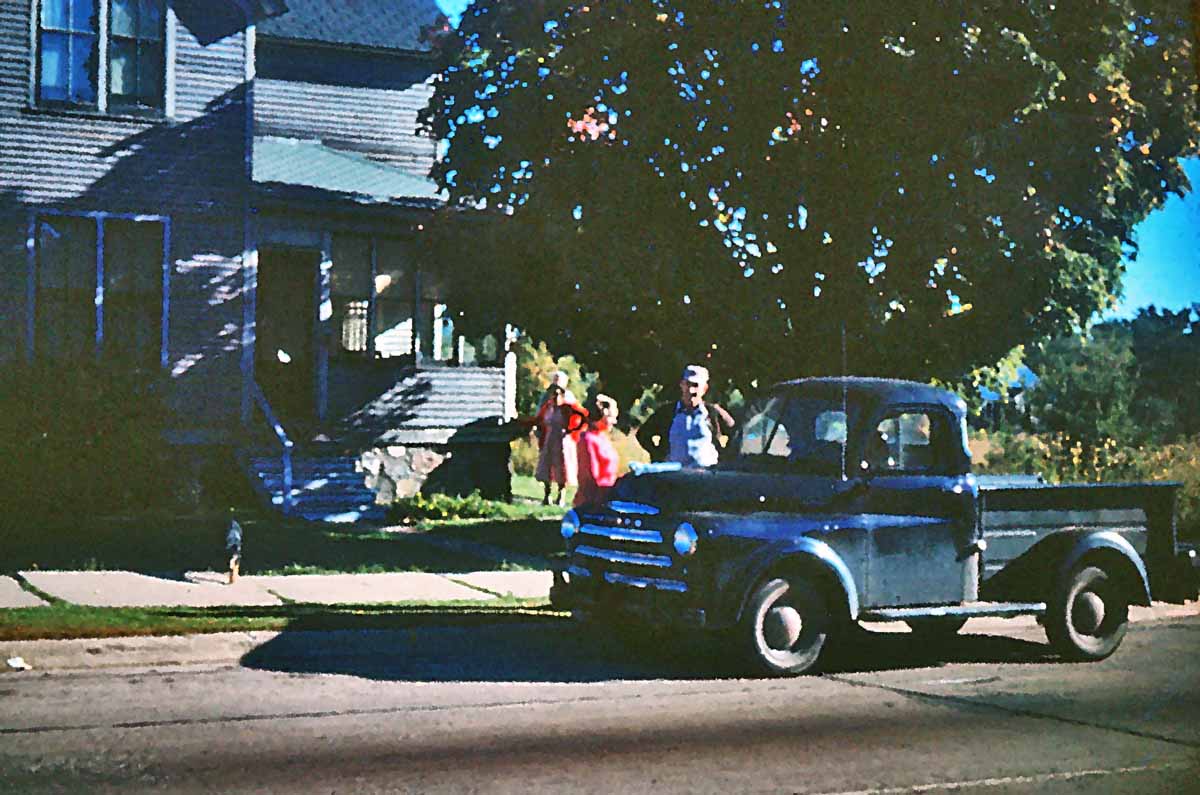
Robert's grandmother Alida, wife Ruth, and grandfather Arvid at his grandparent's LA home this year
|













